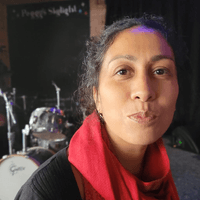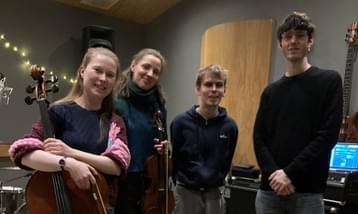Producer Blog: Child-centred music delivery in SEN settings
NewsNews Story
Over the course of the last few months, Orchestras Live had the opportunity to co-produce a number of projects working in non-mainstream school settings.
One such project took place at Keyham Lodge School in Leicestershire. Many of the students attending the school have very complex needs, including children on the autistic spectrum, with ADHD, attachment and conduct disorders, oppositional and defiance disorders, learning disorders and disabilities.
On my visits, I was able to see how the approach to learning and creative exchange in this setting drove the design and delivery of the process, and what this could offer to music provision in other environments working with children and young people.
The provision of music technology at Keyham Lodge is strong and delivered well. Steve Duguid, the music lead at the school, shared a clear vision to give students the opportunity to play orchestral instruments in order to allow them to further their music skills. Sessions were co-designed accordingly with Steve, Sinfonia Viva, music leader, James Redwood, and Leicestershire Music tutors. The project lasted six months, with two performances in February and July.
We were aiming to make the early part of the instrumental learning process really exciting because it’s about making music which is satisfying to play, even if you only have one note.
~ Marianne Barraclough, Sinfonia Viva
I had a chat with Marianne Barraclough, Deputy CEO at Sinfonia Viva about the project and how she, Sarah Share from Leicestershire Music, and the musical team set about delivering the work at Keyham Lodge.
The delivery framework needed to fulfil a number of criteria to be successful. As many of the students have specific and complex needs, the environment and way that the project was introduced was paramount. In this instance, the students had never played traditional orchestral instruments, though many had skills in other musical areas.
The first workshops were very much about building an ensemble and making exciting sounding music together quickly. A key element to that was working out which member of the team had a connection with which child, and setting out the music room so that they could support that young person and build that relationship.
Having no preconceptions about each participant’s level of engagement with the sessions or performances and being fully prepared to support them whichever decisions they made, was also something which relieved pressure and allowed for a conducive environment. One-to-one moments for direct instrumental tuition were seamlessly combined with music mentoring and ensemble jamming from time to time.
James Redwood created four pieces, inspired by the group, which formed the basis of the music tuition repertoire which the Leicestershire Music musician Joe Millson took the lead in supporting. As it was unknown how quickly participants would progress, these were written as solo pieces, mostly using one note to start with.
Alongside this, the group created large ensemble jams, which took their starting points from offerings from the students, encompassing newly created pieces, and arrangements of existing pieces, made together in the room. Over time the students incorporated their orchestral instruments into the large ensemble jams, bringing the two musical strands of the project neatly together.
The other key element that Marianne described to me was the importance of celebrating achievements in the moment. For some students they may have a brilliant session, then be unable to even enter the room for the next one.
In this environment, where the reaction to failure can be so destabilising, we held the musical space in a way that protected the young people from feeling failure… It felt important that we tried to limit the opportunities for failure within the project, and instead focused on celebrating success.
~ Marianne Barraclough, Sinfonia Viva
All of the sessions were preceded and concluded with debrief and planning meetings where the team would be able to think about and discuss each child’s progress and any further support they may need.
When I visited the school, it was clear that this was a special project. Of course, challenges arose, some moments were more difficult than others. I noted the understated but solid support that each member of the team offered, attention to the detail of the experience of each individual and the sharing of this in team meetings, constantly striving to improve this music-making environment. The fact that there were around seven adults to ten young people in each of the workshops, and the music lead at Keyham Lodge is passionate about the students’ musical journeys and crystal-clear about his vision for the project, is notable.
Reflecting on the project after its first phase and leaving the school after the most recent performance for parents and families, I am inspired by everyone involved. I think about how music is valued in the school setting, or not, as the case may be. I ask myself whether, in the mainstream setting, there is a need to assume (to some extent) that the children and young people have “bought in” to music lessons because they may be slightly more compliant. It must be recognised that the project at Keyham Lodge was possible because of the resources available.
It's a numbers game. The reason we were able to be that supportive and focused on the individuals in the group was because there were at least seven adults in the room working with usually ten young people… It’s difficult to personalise your approach if you’re working alone with thirty young people.
~ Marianne Barraclough, Sinfonia Viva
I don’t think it particularly controversial to express the idea that all children and young people have specific needs, but it is a reality that resources are nowhere near enough to facilitate this kind of engagement for all children of school age.
We also know that many children with complex needs in mainstream schools remain undiagnosed throughout their school careers. As a sector, we realise this, and do our best to work within these limitations.
However, I do believe that we can learn from projects and settings that place the child and their learning and creative environment at the centre – before even thinking about introducing an activity. To my mind, this project is what music in all schools should (dare I say could), look like one blue sky day.


